Caryn
 In the toughest of times, the women of the west had to participate in the work force since families had to make ends meet any way they could. But the work was demanding, often outdoors and with physical labor and lots of hours doing agricultural and other large-scale jobs. By the end of the day, they were exhausted…just like their men. It’s not that women aren’t capable of hard work, because they absolutely are. Nevertheless, their bodies aren’t built for the same kind of work as the men…or at least it isn’t as easy as for the men.
In the toughest of times, the women of the west had to participate in the work force since families had to make ends meet any way they could. But the work was demanding, often outdoors and with physical labor and lots of hours doing agricultural and other large-scale jobs. By the end of the day, they were exhausted…just like their men. It’s not that women aren’t capable of hard work, because they absolutely are. Nevertheless, their bodies aren’t built for the same kind of work as the men…or at least it isn’t as easy as for the men.
During World War I and World War II, when so many men were called to duty, and so many were killed, the workforce at home was dramatically shrinking. So, like they always did, the women stepped up. It’s not that the men weren’t stepping up too, 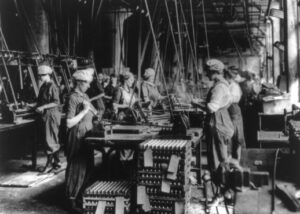 because going to war is most certainly stepping up. Really, everyone was doing a job that was not in their normal wheelhouse. Times were tough and tough times called for tough people. It the war was going to be won, the military had to be supplied with the necessary materials to fight with. Things like ammunition, uniforms, boots, tanks, planes, bombs, guns, and much more were vital; and without the help of the women back home, the men would not have the things they needed to win the war.
because going to war is most certainly stepping up. Really, everyone was doing a job that was not in their normal wheelhouse. Times were tough and tough times called for tough people. It the war was going to be won, the military had to be supplied with the necessary materials to fight with. Things like ammunition, uniforms, boots, tanks, planes, bombs, guns, and much more were vital; and without the help of the women back home, the men would not have the things they needed to win the war.
The thing about these particular women was that at that time in history, most women were stay-at-home moms, and at that time that really meant cleaning the house, cooking, and caring for the children. These were not times of going to the gym to work out, and the main exercise was the daily chores. Don’t get me wrong, because the chores  were hard work, and that did keep the women in shape, but they weren’t miners or factory workers. This necessary work was all new to them. The endeavor to bring these women into the workforce was no small undertaking. The had to be trained and trained quickly. There was no time to waste. The women, for their part, jumped at the chance to help their men and the men of the nation. They learned their new jobs quickly and did their jobs efficiently. They were loyal to their men and their country, and they were willing to take on the exhausting jobs they were asked to take on. In fact, I don’t think the wars could have been won, without both parts…the men and the women, and the necessary work they did.
were hard work, and that did keep the women in shape, but they weren’t miners or factory workers. This necessary work was all new to them. The endeavor to bring these women into the workforce was no small undertaking. The had to be trained and trained quickly. There was no time to waste. The women, for their part, jumped at the chance to help their men and the men of the nation. They learned their new jobs quickly and did their jobs efficiently. They were loyal to their men and their country, and they were willing to take on the exhausting jobs they were asked to take on. In fact, I don’t think the wars could have been won, without both parts…the men and the women, and the necessary work they did.

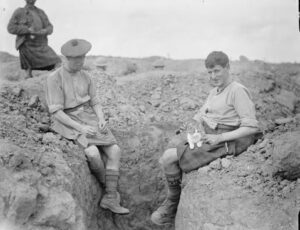 Trench warfare is a type of land warfare using occupied lines largely comprising military trenches, in which troops are well-protected from the enemy’s small arms fire and are substantially sheltered from artillery. That doesn’t protect them from many other weapons, like tanks, bomber planes, and some things that seem far more benign…rats and disease, not that these things aren’t dangerous. In fact, during World War I, these seemingly benign pests were becoming a deadly problem. Trench foot was one of the biggest disease problems, due to the wet and dirty conditions the men basically lived in.
Trench warfare is a type of land warfare using occupied lines largely comprising military trenches, in which troops are well-protected from the enemy’s small arms fire and are substantially sheltered from artillery. That doesn’t protect them from many other weapons, like tanks, bomber planes, and some things that seem far more benign…rats and disease, not that these things aren’t dangerous. In fact, during World War I, these seemingly benign pests were becoming a deadly problem. Trench foot was one of the biggest disease problems, due to the wet and dirty conditions the men basically lived in.
The rats…well, they were a bigger problem. The fact that the men “lived” in the trenches meant things like human waste, food scraps, and dead bodies drew the rats, and rats spread disease like typhus and the plague,  which made the problem of disease more deadly. Since trash disposal wasn’t easy in the trenches, the men often threw empty food tins out of the trenches at night. Then, the rats could be heard turning the tins over and licking the last tidbits out of them. For me the whole scene would be enough to make me want to run screaming from the scene, but that could get a soldier killed. Something had to be done…and done quickly. Due to the plentiful amount of food, some of these rats grew quite large in size. One story tells of a soldier who spotted one the size of a cat.
which made the problem of disease more deadly. Since trash disposal wasn’t easy in the trenches, the men often threw empty food tins out of the trenches at night. Then, the rats could be heard turning the tins over and licking the last tidbits out of them. For me the whole scene would be enough to make me want to run screaming from the scene, but that could get a soldier killed. Something had to be done…and done quickly. Due to the plentiful amount of food, some of these rats grew quite large in size. One story tells of a soldier who spotted one the size of a cat.
Something had to be done, so French troops tried to control the rat problem by bringing terrier dogs into the trenches with them. The plan was to let the dogs catch and kill rats, and it quickly became an interesting way to pass the time during daylight hours. Because of the dangers presented by the rats, the military actually offered soldiers a reward for killing the rats as incentive to decrease their numbers. It was a great idea, but not really practical, because rats are notoriously great escape artists…at least from humans. Nevertheless, apparently the troops got so into the 
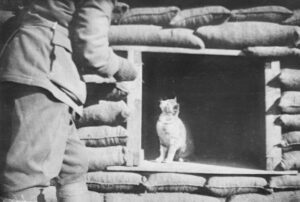 game, with one army corps managed to catch 8,000 in a single night. Other soldiers adopted cats instead of dogs, and it’s believed around 500,000 cats helped out in the trenches over the course of World War I. Many of the cats, and some of the dogs, ended up serving as mascots for troops on the front lines as well as hunters. I guess the plan worked, but maybe the animals should have been given a medal too.
game, with one army corps managed to catch 8,000 in a single night. Other soldiers adopted cats instead of dogs, and it’s believed around 500,000 cats helped out in the trenches over the course of World War I. Many of the cats, and some of the dogs, ended up serving as mascots for troops on the front lines as well as hunters. I guess the plan worked, but maybe the animals should have been given a medal too.

 On November 12th, 2022, my nephew, Allen Beach and his wife, Gaby “left Wyoming in the rearview mirror” on their way to Eugene, Oregon. We were all sorry to see them go. They had been here for over two years, and it was really the first time they had been so near to this side of the family…since Allen was in middle school. So much has changed in the years since Allen was a kid. He graduated from high school and joined the Navy. His tour of duty would take him to Japan, where he met his beautiful wife, while both were corpsmen stationed there. They are so well suited for each other. They are both athletic people who love hiking and traveling. Which might also be part of the draw toward Oregon. Lots of beautiful places to hike…not to mention that Gaby is originally from Oregon, and they both knew deep down that they would most likely end up there.
On November 12th, 2022, my nephew, Allen Beach and his wife, Gaby “left Wyoming in the rearview mirror” on their way to Eugene, Oregon. We were all sorry to see them go. They had been here for over two years, and it was really the first time they had been so near to this side of the family…since Allen was in middle school. So much has changed in the years since Allen was a kid. He graduated from high school and joined the Navy. His tour of duty would take him to Japan, where he met his beautiful wife, while both were corpsmen stationed there. They are so well suited for each other. They are both athletic people who love hiking and traveling. Which might also be part of the draw toward Oregon. Lots of beautiful places to hike…not to mention that Gaby is originally from Oregon, and they both knew deep down that they would most likely end up there.


Their college behind them, Gaby is a nurse, and Allen has a degree in Hospital Administration. Allen was hired by Wyoming Medical Center as the department manager over the Referral and Communications Departments. Later, he also became department manager over the EMS Department, but once again, things changed, and the hospital changed hands. Allen’s job was eliminated, so he and Gaby opted for the move to Oregon. Gaby found a job as a nurse for the Veterans Administration, and she likes it very much. Allen is looking at several options there, and while he is weighing the options, he is working on getting them settled in. For now, they have decided to lease an apartment. That will give them time to become acquainted with their new city and to decide in which part of town they would like to live.


Moving to Oregon is a new adventure for them, but not their first move. Their naval careers and college days have taken them to many different locations, including the time in Japan and also time at Walter Reed National Military Medical Center in Bethesda, Maryland. They also took a trip to Bali, which was where Allen proposed to Gaby. I’m sure they will take lots of trips in the future, even if they don’t move again. Today is Allen’s birthday. Happy birthday Allen!! Have a great day!! We love you!!

 As a kid, and especially as a teenager…those stupid ‘I know everything’ years, I like many kids thought my mother, Collene Spencer couldn’t possibly understand life as it was in my day. I think we all thought our parents were ‘older than dirt’ in our teen years. Then, we grow up and become parents, and suddenly, we find out how much our parents really did know. I found out that my mom was really a wise woman. Yes, she was wise in the ways of raising a family and managing a household, but my mom was also very wise in the ways of the Lord. I think if she had chosen to, she could have been an evangelist…not that she wasn’t really. What ’embarrassed’ me, was simply my mom telling anyone who would listen, about the Lord. When this happened in stores and such, I wanted to crawl under the floor. I kept thinking, “Mom, they don’t want to hear that…from you or anyone else!! Please leave them alone!!” Of course, I was wrong to do that. Mom saw what I didn’t…a person in need of the Lord. I can only imagine how many people she brought to Jesus…either that she knew of or that she never knew of. Knowing my mom, she immediately claimed Isaiah 55:11 over them, which says, “So shall My word be that goes forth from My mouth; It shall not return to Me void, but it shall accomplish what I please, and it shall prosper in the thing for which I sent it.”
As a kid, and especially as a teenager…those stupid ‘I know everything’ years, I like many kids thought my mother, Collene Spencer couldn’t possibly understand life as it was in my day. I think we all thought our parents were ‘older than dirt’ in our teen years. Then, we grow up and become parents, and suddenly, we find out how much our parents really did know. I found out that my mom was really a wise woman. Yes, she was wise in the ways of raising a family and managing a household, but my mom was also very wise in the ways of the Lord. I think if she had chosen to, she could have been an evangelist…not that she wasn’t really. What ’embarrassed’ me, was simply my mom telling anyone who would listen, about the Lord. When this happened in stores and such, I wanted to crawl under the floor. I kept thinking, “Mom, they don’t want to hear that…from you or anyone else!! Please leave them alone!!” Of course, I was wrong to do that. Mom saw what I didn’t…a person in need of the Lord. I can only imagine how many people she brought to Jesus…either that she knew of or that she never knew of. Knowing my mom, she immediately claimed Isaiah 55:11 over them, which says, “So shall My word be that goes forth from My mouth; It shall not return to Me void, but it shall accomplish what I please, and it shall prosper in the thing for which I sent it.”
Mom knew her Bible, and could be found reading it, listening to it, or listening to Bible teachings every day…pretty much all day. It was only after her passing on February 22, 2015, that I really knew that quietly, behind the scenes, my mom had been ‘secretly’ sharing the gospel with people, and many were saved because of her. She also had a way of being a type of counselor to people…not people with real big problems, necessarily, but just a person who could be counted on to listen when needed. That truly was my mom. She always had an ear to hear, and a caring heart. She was a person who always gave of herself and anything she had, if someone needed it. So many people have told me since her graduation to Heaven, that she was there for them with just the right words, when they needed them most. It was truly ‘Mom’s Secret Legacy’ and so welcomed by so many.
It was her secret, probably because she knew that her girls (I was probably the worst) would try to have her not do the work she felt led to do. She did of course, talk to all of her family, as well as her siblings and Dad’s 
 siblings…whether we wanted her to or not. She wanted all of us to be in Heaven with he when our turn came…and how thankful we all are that she was that way. We all think of a legacy as something that just happens easily, but it isn’t it takes work, time, and sacrifice, and most people do it without even knowing that they are building a legacy. That was my mom, exactly!! Today would have been my mom’s 87th birthday…our New Year’s Baby!! Happy birthday in Heaven, Mom!! I know you and Dad are having the time of your lives!! We love and miss you both very much, and we can’t wait to see you again!!
siblings…whether we wanted her to or not. She wanted all of us to be in Heaven with he when our turn came…and how thankful we all are that she was that way. We all think of a legacy as something that just happens easily, but it isn’t it takes work, time, and sacrifice, and most people do it without even knowing that they are building a legacy. That was my mom, exactly!! Today would have been my mom’s 87th birthday…our New Year’s Baby!! Happy birthday in Heaven, Mom!! I know you and Dad are having the time of your lives!! We love and miss you both very much, and we can’t wait to see you again!!

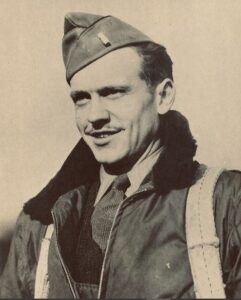 Because my dad, Allen Spencer was the flight engineer and top turret gunner on a B-17G in World War II, the B-17 has always held my interest. The plane was practically indestructible because of its great flying characteristics, resistance to combat damage, and fierce defensive firepower. Built by Boeing, it was called the B-17 Flying Fortress and it was the backbone of the American bomber force in Europe. In the European Theater of World War II (1939-1945), “one of the most dangerous occupations for Allied soldiers, sailors, or airmen was the flying of strategic bombers.” That was a statement that surprised me a little, because I would have expected the men on the ground to be in far more danger. I knew that there was a time my dad had to hang out of the open bomb bay doors to crank the landing gear down when they were damaged in combat, and I vaguely recall that they lost a ball turret gunner when he was wounded in battle and, while they pulled him out to render aid, they couldn’t save him.
Because my dad, Allen Spencer was the flight engineer and top turret gunner on a B-17G in World War II, the B-17 has always held my interest. The plane was practically indestructible because of its great flying characteristics, resistance to combat damage, and fierce defensive firepower. Built by Boeing, it was called the B-17 Flying Fortress and it was the backbone of the American bomber force in Europe. In the European Theater of World War II (1939-1945), “one of the most dangerous occupations for Allied soldiers, sailors, or airmen was the flying of strategic bombers.” That was a statement that surprised me a little, because I would have expected the men on the ground to be in far more danger. I knew that there was a time my dad had to hang out of the open bomb bay doors to crank the landing gear down when they were damaged in combat, and I vaguely recall that they lost a ball turret gunner when he was wounded in battle and, while they pulled him out to render aid, they couldn’t save him.
What I didn’t know about was something that happened on January 1, 1945, that was so bizarre that it seems like a ‘tall tale’ more than an actual event. Nevertheless, it was an actual event, and it was shocking. On that day, the Flying Fortress and the men who flew them were going to be tested beyond any limits they could have imagined, and beyond anything they were trained for. During a chaotic battle complete with ferocious anti-aircraft gunfire (flak) and enemy fighters, two B-17 Bombers managed to collide. A B-17, number 43-338457, piloted by 1st Lieutenant William G MacNab and 2nd Lieutenant Nelson B Vaughn, had risen upward. The top turret guns on MacNab’s plane had pierced through the aluminum skin on the bottom of 1st Lieutenant Glenn H Rojohn’s B-17, number 42-231987, binding the two huge planes together, as Rojohn’s co-pilot 2nd Lieutenant William G Leek, Jr said, like ‘breeding dragonflies.’ The two planes had become one. Upon impact, instead of exploding or breaking into pieces, the colliding planes became stuck together in a piggyback fashion, one atop the other. I’m sure that the men in the top plane, at least were in shock at this strange turn of affairs. I say the top plane, because it is thought that the men in the bottom plane were incapacitated or dead. There was no communication with them. Once the men realized that they weren’t going to crash, they would have to figure out their next move.
Even more shocked than the crew of the B-17 were the German fighter pilots who suddenly saw the whole confusing, but disastrous event. People just don’t expect that a mid-air collision could result in two planes stuck together. For the German fighter pilots, however, the situation took on an even more bizarre tone, because they honestly thought that the US must have created some sort of new secret weapon!! For the men onboard, the situation was dire. I’m sure they expected the explosion to come at any moment, so some of the airmen bailed out. The pilot of the top bomber, Rojohn tried, but was unable to separate the aircraft. Strangely, he was able to control the flight of the ‘hybrid dual-bomber’ somehow, despite turning his own engines off. The lower plane’s engines were still running, because its propellers were still turning. There was no communication with the crew of the bottom plane, which is why it was assumed that they were either incapacitated or already dead.
In a valiant effort, Rojohn decided to try to land the planes, probably hoping that the other crew could be saved, and complicated by the fact that he and his co-pilot, Leek couldn’t get out anyway. At that point, he might as well do his best to save the two or more of them that he could. He coaxed the joined bombers to a relatively safe landing in Germany at Wilhemshaven. Unfortunately, the lower bomber slid out from under the top bomber upon landing and immediately exploded. While the crew of the lower bomber perished in the landing and subsequent explosion, most of the crew of Rojohn’s B-17 survived and was taken prisoner. While being held in the camps, the German interrogators, who were skeptical of the account of the incident given by 
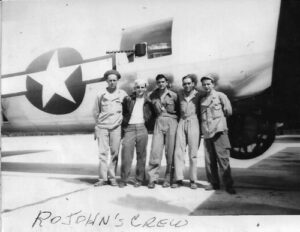 Rojohn, initially were of the opinion the flight represented a new American aerial design. I’m sure they later realized their error, but they must have also realized the resiliency of the B-17 Flying Fortress. Rojohn and his co-pilot, Leek, earned the Distinguished Flying Cross for their feat of aerial skill…a well-deserved award, if you ask me.
Rojohn, initially were of the opinion the flight represented a new American aerial design. I’m sure they later realized their error, but they must have also realized the resiliency of the B-17 Flying Fortress. Rojohn and his co-pilot, Leek, earned the Distinguished Flying Cross for their feat of aerial skill…a well-deserved award, if you ask me.

 There are a number of different kinds of governments, and people disagree on which is the best. Personally, I think that any government that takes away the freedoms of its people is destined to fail. Communism is a “political theory derived from Karl Marx, advocating class war and leading to a society in which all property is publicly owned, and each person works and is paid according to their abilities and needs.” Communism is also, known as Marxism, which is defined as “the political and economic theories of Karl Marx and Friedrich Engels, later developed by their followers to form the basis for the theory and practice of communism.” I don’t think most people know the real meaning of Marxism or Communism, or, for that matter, Socialism, which is “a political and economic theory of social organization which advocates that the means of production, distribution, and exchange should be owned or regulated by the community as a whole.” If people knew what these types of governments are really like, they would fight to keep them out of their countries. The problem is that people think the government will take care of them, and that they will benefit from the work of others. It never works that way. everyone in these situations gets poorer, except for the government.
There are a number of different kinds of governments, and people disagree on which is the best. Personally, I think that any government that takes away the freedoms of its people is destined to fail. Communism is a “political theory derived from Karl Marx, advocating class war and leading to a society in which all property is publicly owned, and each person works and is paid according to their abilities and needs.” Communism is also, known as Marxism, which is defined as “the political and economic theories of Karl Marx and Friedrich Engels, later developed by their followers to form the basis for the theory and practice of communism.” I don’t think most people know the real meaning of Marxism or Communism, or, for that matter, Socialism, which is “a political and economic theory of social organization which advocates that the means of production, distribution, and exchange should be owned or regulated by the community as a whole.” If people knew what these types of governments are really like, they would fight to keep them out of their countries. The problem is that people think the government will take care of them, and that they will benefit from the work of others. It never works that way. everyone in these situations gets poorer, except for the government.
The Union of Soviet Socialist Republics (USSR) was established in post-revolutionary Russia, on December 30, 1922. It combined Russia, Belorussia, Ukraine and the Transcaucasian Federation (which was divided in 1936 into the Georgian, Azerbaijan and Armenian republics). The new nation was also known as the Soviet Union. It was the successor to the Russian Empire and the first country in the world to be based on Marxist socialism. The rest of the world was rather stunned that this kind of regie actually existed, because it took away so many freedoms and personal property, and the people had no choice.
Because Russia was reeling from the Russian Revolution of 1917 and subsequent three-year Russian Civil War, the Bolshevik Party under Vladimir Lenin dominated the soviet forces. A coalition of workers’ and soldiers’ committees called for the establishment of a socialist state in the former Russian Empire. It was from there that the USSR was formed, and after that, all levels of government were controlled by the Communist Party, and the party’s Politburo, with its increasingly powerful general secretary, who effectively ruled the country. Everything, from Soviet industry was owned and managed by the state, and agricultural land was immediately confiscated and divided into state-run collective farms.
Over the coming decades, the Russian-dominated Soviet Union grew into one of the world’s most powerful and influential states. It eventually encompassed 15 republics…Russia, Ukraine, Georgia, Belorussia, Uzbekistan, Armenia, Azerbaijan, Kazakhstan, Kyrgyzstan, Moldova, Turkmenistan, Tajikistan, Latvia, Lithuania and Estonia. 
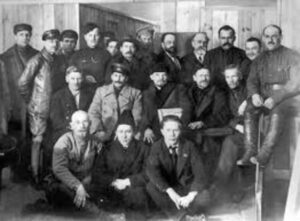 The USSR, as many knew it must, eventually failed because you can’t place people into a slave state without eventual rebellion. In 1991, the Soviet Union was dissolved following the collapse of its communist government. Communism, Marxism, and Socialism simply won’t work in the long run. If a nation wants growth and prosperity, they must have capitalism, so that the people have the incentive to be entrepreneurs, inventors, scientists, and so many other occupations in which discovery is made. Without incentive, people will simply quit.
The USSR, as many knew it must, eventually failed because you can’t place people into a slave state without eventual rebellion. In 1991, the Soviet Union was dissolved following the collapse of its communist government. Communism, Marxism, and Socialism simply won’t work in the long run. If a nation wants growth and prosperity, they must have capitalism, so that the people have the incentive to be entrepreneurs, inventors, scientists, and so many other occupations in which discovery is made. Without incentive, people will simply quit.
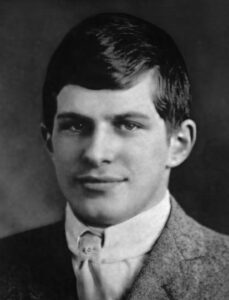
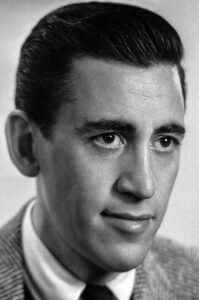 They say that genius can be the closest thing to crazy, but I don’t really know how true that is. Sometimes I think that when a person is a genius, people drive them crazy. It’s the novelty of the thing, I suppose. People find out that the genius has a super high IQ, and they all seem to want something from them. Many people don’t really care about the genius as a person, just about how they might be able to make money off of them somehow. Not every inventor is a genius, but some of them are, as are some mathematicians, doctors, teachers, writers, and many other people too.
They say that genius can be the closest thing to crazy, but I don’t really know how true that is. Sometimes I think that when a person is a genius, people drive them crazy. It’s the novelty of the thing, I suppose. People find out that the genius has a super high IQ, and they all seem to want something from them. Many people don’t really care about the genius as a person, just about how they might be able to make money off of them somehow. Not every inventor is a genius, but some of them are, as are some mathematicians, doctors, teachers, writers, and many other people too.
Sometimes the demands placed on these geniuses gets to be so heavy, that they might just snap. I don’t mean that they might go insane, although some of them have. The thing that seems to happen most, however, is that they might just decide to disappear. Several geniuses have simply vanished,  including William Sidis (who graduated from Harvard at 16, only to go into hiding, going from city to city and job to job), JD Salinger (author of Catcher in the Rye, who left Manhattan in 1953 to live on a “90-acre compound” in Cornish, NH. He remained there until his death in 2010, at age 91, saying he loved to write, but publishing was a terrible invasion of his privacy), Ettore Majorana (a theoretical physicist was considered one of the most deeply brilliant men in the world by Enrico Fermi, creator of the first nuclear reactor. One day he drained his bank account and simply vanished), David Thorne (an architect received so much attention for his work on jazz giant Dave Brubeck’s house in 1954, that he changed his professional name in the ‘60s to Beverly Thorne, got an unlisted phone number, and didn’t “resurface” until the 1980s), and Nick Gill (who at 21, was the youngest-ever British chef to win a Michelin star. He seemed destined for a life of fame and fortune and was hailed as a culinary genius. One day he told his brother he was going to disappear, and to “please, not look for him,” never to be seen again).
including William Sidis (who graduated from Harvard at 16, only to go into hiding, going from city to city and job to job), JD Salinger (author of Catcher in the Rye, who left Manhattan in 1953 to live on a “90-acre compound” in Cornish, NH. He remained there until his death in 2010, at age 91, saying he loved to write, but publishing was a terrible invasion of his privacy), Ettore Majorana (a theoretical physicist was considered one of the most deeply brilliant men in the world by Enrico Fermi, creator of the first nuclear reactor. One day he drained his bank account and simply vanished), David Thorne (an architect received so much attention for his work on jazz giant Dave Brubeck’s house in 1954, that he changed his professional name in the ‘60s to Beverly Thorne, got an unlisted phone number, and didn’t “resurface” until the 1980s), and Nick Gill (who at 21, was the youngest-ever British chef to win a Michelin star. He seemed destined for a life of fame and fortune and was hailed as a culinary genius. One day he told his brother he was going to disappear, and to “please, not look for him,” never to be seen again).
It isn’t known, as to why these geniuses would decide that they no longer wanted to be a part of the world, nor 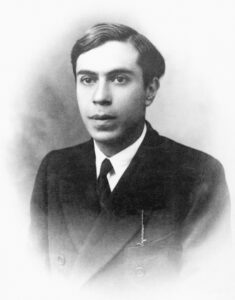
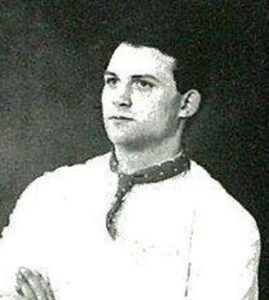 are they to only people to do this by any means. Nevertheless, they seem to have one thing in common, their genius skill or knowledge seemed to take over their whole life, and people wouldn’t leave them alone, but rather hounded them unmercifully. I think I can understand how that would be enough to make someone want to disappear, but most people don’t actually go so far as to take that step. It is a rather extreme step to take, and for all we know some of these might have been killed or committed suicide. The sad reality for these genius minds is that the fame and constant pressure of celebrity was too much for them, and they just checked out, because the burden of knowledge was just too much for them.
are they to only people to do this by any means. Nevertheless, they seem to have one thing in common, their genius skill or knowledge seemed to take over their whole life, and people wouldn’t leave them alone, but rather hounded them unmercifully. I think I can understand how that would be enough to make someone want to disappear, but most people don’t actually go so far as to take that step. It is a rather extreme step to take, and for all we know some of these might have been killed or committed suicide. The sad reality for these genius minds is that the fame and constant pressure of celebrity was too much for them, and they just checked out, because the burden of knowledge was just too much for them.
 For thousands of years, people have wanted to feel like they left a mark on this Earth…a way to say, “I was here.” Not everyone could be famous, and in fact most people aren’t famous, nor would they want to be. Still, they want to feel like their life mattered…like someone cared that they had lived. Many of us, in fact most people are not famous. They are just everyday people who go about their daily lives…working, raising families, going to school and church, and spending time with families. Their lives would not be thought of as spectacular. Still for most people, someone…somewhere cares that they existed. Nevertheless, in 100 years it’s quite likely that no one will even remember their name.
For thousands of years, people have wanted to feel like they left a mark on this Earth…a way to say, “I was here.” Not everyone could be famous, and in fact most people aren’t famous, nor would they want to be. Still, they want to feel like their life mattered…like someone cared that they had lived. Many of us, in fact most people are not famous. They are just everyday people who go about their daily lives…working, raising families, going to school and church, and spending time with families. Their lives would not be thought of as spectacular. Still for most people, someone…somewhere cares that they existed. Nevertheless, in 100 years it’s quite likely that no one will even remember their name.
These days that may be changing with sites like Ancestry.com, My Heritage, 23 and Me, and probably others, people find it easier to be “known” by the masses. Still, many people don’t even notice if a friend lands in Facebook Jail…until they get out and tell everyone. Really most of us just live our lives…day by day, expecting everything to be normal and no real excitement. With that in mind, some people found a new way to leave a  little piece of their lives in a safe place to be found by someone else, years later. In fact, it has become a big deal…called a “Time Capsule” but it isn’t new. There was a time capsule at the high school I graduated from, and its opening years later was documented by my niece, Liz Masterson, who graduated from there too, and now is a teacher there. There was also a time capsule in a local restaurant that was found when they did some remodeling many years later. Some time capsules are even older, such as the one found in 2015 in the Cairngorms National Park in Scotland. This one was a 121-year-old time capsule, and it was discovered by construction workers on a section of the Ruthven Road bridge.
little piece of their lives in a safe place to be found by someone else, years later. In fact, it has become a big deal…called a “Time Capsule” but it isn’t new. There was a time capsule at the high school I graduated from, and its opening years later was documented by my niece, Liz Masterson, who graduated from there too, and now is a teacher there. There was also a time capsule in a local restaurant that was found when they did some remodeling many years later. Some time capsules are even older, such as the one found in 2015 in the Cairngorms National Park in Scotland. This one was a 121-year-old time capsule, and it was discovered by construction workers on a section of the Ruthven Road bridge.
Time capsules can be any kind of container. They just need to be able to stand up to the environment they are placed in. A wooden box is ok in a place that won’t get wet, and most times people try to place things in such a place. The Cairngorms National Park capsule was a metal box, similar to a safe-deposit box at a bank. The excitement around the time capsule grew, and when it was opened, the items inside that were found included… a bottle of whisky, a newspaper from 1894, a scroll, and some other items. As often happens, the items and the box itself were donated to the nearby Highland Folk Museum to be studied. As to the timeframe, it is believed that the time capsule was placed within the structure of the bridge when it was originally constructed at the end of the 19th century, so the 1894 newspaper wasn’t far off. Of course, unless there were specific names in the box, the people in the particular show of “I was here” will remain a mystery. Still, they will be remembered, even if we don’t know exactly who “they” were.
a bottle of whisky, a newspaper from 1894, a scroll, and some other items. As often happens, the items and the box itself were donated to the nearby Highland Folk Museum to be studied. As to the timeframe, it is believed that the time capsule was placed within the structure of the bridge when it was originally constructed at the end of the 19th century, so the 1894 newspaper wasn’t far off. Of course, unless there were specific names in the box, the people in the particular show of “I was here” will remain a mystery. Still, they will be remembered, even if we don’t know exactly who “they” were.

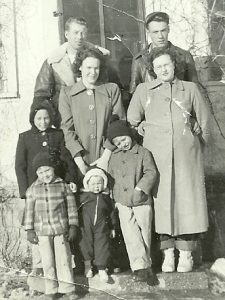 My husband’s aunt, Esther Hein, as a young girl living in the country near Forsyth, Montana, spent some of her school years living in a “boarding house” of sorts. It wasn’t really, but it may have seemed like it to her, except that the owners of the “boarding house” were her half-brother, Walt Schulenberg and sister-in-law, Joann Schulenberg. The problem Esther’s parents, Vina and Walt Hein, faced was that Esther needed to go to school on a regular basis, and the Montana winters had a way of creating a “snowed in” situation for the people who lived in the country. The people living in town could still get their kids to school, but the long country roads could not always be cleared, and when the snow was deep, they mostly couldn’t. So, they often didn’t try. That meant those kids living in the country didn’t get to school when the snow got deep, and as we all know, missing too much school means that the child isn’t going to pass.
My husband’s aunt, Esther Hein, as a young girl living in the country near Forsyth, Montana, spent some of her school years living in a “boarding house” of sorts. It wasn’t really, but it may have seemed like it to her, except that the owners of the “boarding house” were her half-brother, Walt Schulenberg and sister-in-law, Joann Schulenberg. The problem Esther’s parents, Vina and Walt Hein, faced was that Esther needed to go to school on a regular basis, and the Montana winters had a way of creating a “snowed in” situation for the people who lived in the country. The people living in town could still get their kids to school, but the long country roads could not always be cleared, and when the snow was deep, they mostly couldn’t. So, they often didn’t try. That meant those kids living in the country didn’t get to school when the snow got deep, and as we all know, missing too much school means that the child isn’t going to pass.
So, in what is really one of the sweetest and funniest stories about Aunt Esther that I know, Esther moved in with her brother and sister-in-law. Things usually went smoothly, but you must understand that Esther was a child, with child-like ways at the time. There were times that she didn’t get along with her brother, sister-in-law, and cousins. It was nothing major, just kid stuff and maybe a little sassiness. My future mother-in-law, and Esther’s sister-in-law, Joann sometimes got tired and annoyed. She might have been able to spank her sister-in-law, but she might not have felt comfortable doing that either. That said, when she was annoyed with Esther, her common comment was “Don’t Esther!!” This might seem like it isn’t very funny, but later in life, my mother-in-law had Alzheimer’s Disease…which isn’t exactly funny either.
Nevertheless, my mother-in-law had her “funny” Alzheimer’s moments, as they all do, if you look beyond the disease. She didn’t always like things like going to bed, taking a walk around the house, or especially telling her to stop scratching her itchy skin. Since I was her caregiver quite often, I was the “bad guy” that made her do 
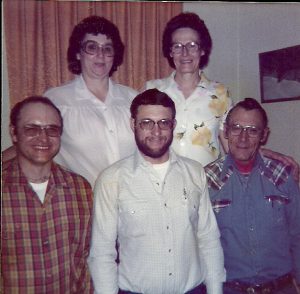 these things. Her very itchy skin, and the fact that she scratched too hard, caused injury to her skin, so I had to stop her from scratching. Whenever I try to stop her, she would say, “Don’t Esther!!” The first time she said that I was shocked, but once I heard the “Don’t Esther” story, I finally understood that she was mistaking me for Esther in those moments. For me it was liberating. That meant that sometimes when my mother-in-law was mad at me, I could let Esther take the blame. Sorry Esther, but it worked for me. Today is Esther’s 82nd birthday. Happy birthday Esther!! Have a great day!! We love you!!
these things. Her very itchy skin, and the fact that she scratched too hard, caused injury to her skin, so I had to stop her from scratching. Whenever I try to stop her, she would say, “Don’t Esther!!” The first time she said that I was shocked, but once I heard the “Don’t Esther” story, I finally understood that she was mistaking me for Esther in those moments. For me it was liberating. That meant that sometimes when my mother-in-law was mad at me, I could let Esther take the blame. Sorry Esther, but it worked for me. Today is Esther’s 82nd birthday. Happy birthday Esther!! Have a great day!! We love you!!

 Just outside the little village of Chatillon in Southern Belgium, on top of a tree covered hill, hidden from view, there was a “car cemetery” filled with cars that once belonged to the US servicemen stationed there. No one really knows how the soldiers came to obtain the cars exactly, especially since they were mostly American made cars…meaning they must have been shipped over to Belgium. So, the soldiers who were stationed in Belgium during World War II somehow had cars to drive to get around while they were serving over there.
Just outside the little village of Chatillon in Southern Belgium, on top of a tree covered hill, hidden from view, there was a “car cemetery” filled with cars that once belonged to the US servicemen stationed there. No one really knows how the soldiers came to obtain the cars exactly, especially since they were mostly American made cars…meaning they must have been shipped over to Belgium. So, the soldiers who were stationed in Belgium during World War II somehow had cars to drive to get around while they were serving over there.
Then, once the war was over, the soldiers returned to the United States. I suppose that bringing the vehicles over happened a few at a time, but shipping them back would be a massive undertaking, so it was decided to leave them behind. To me, it would seem like they should have given the cars away. At least that way, people in the area could have a car, when they might not have been able to afford one any other way. Nevertheless, that was not how it was done. The officers in charge decided to leave them in the country and parked them all up at the top of a hill, which was hidden from view. It was left up to the individual soldier whether or not they wanted to have their car shipped to them once they returned home, at their own expense. Not one of them decided to retrieve their car. These days the way things took place in the end, would have very likely cause an international uproar because they basically littered the landscape with junk cars. Of course, they weren’t junk at the time, and I suppose the people of the area could have taken the cars as abandoned. I’m not sure how they would have run when it was finally determined that they were abandoned, and maybe it was decided that it would cost too much. That may be the reason that none of the soldiers ever claimed their vehicles…a cost too heavy and no help in sight.
After many years, the forest was in the process of making very slow work of returning the cars to nature. The stories about the “Car Cemetery” persisted, and possibly complaints too. It was said that American-made cars had been brought by American and Canadian NATO troops to a mechanic in Châtillon. One by one, the cars were driven up a hill, parked, and somehow hidden from the outside world. Eventually, local people added their own old cars too. Possibly the mechanic was to keep them for the soldiers, but after France’s 1966 withdrawal from NATO, he was left “holding the bag” as it were, with hundreds of scrap cars that gradually became overgrown until a television documentary brought the “illegal dump” to light. Finally, the cars were removed and crushed in October 2010.
To date, some of the cars are said to still be there. At one point there was not one but four car graveyards 
 around the village of Chatillon with as many as 500 vehicles. The ones that remain today are only a fraction of the original number of cars. A lot of cars and their parts were stolen by the locals and international car collectors, so maybe some of them have been restored before they were completely lost. Either way, it was a very strange situation.
around the village of Chatillon with as many as 500 vehicles. The ones that remain today are only a fraction of the original number of cars. A lot of cars and their parts were stolen by the locals and international car collectors, so maybe some of them have been restored before they were completely lost. Either way, it was a very strange situation.

